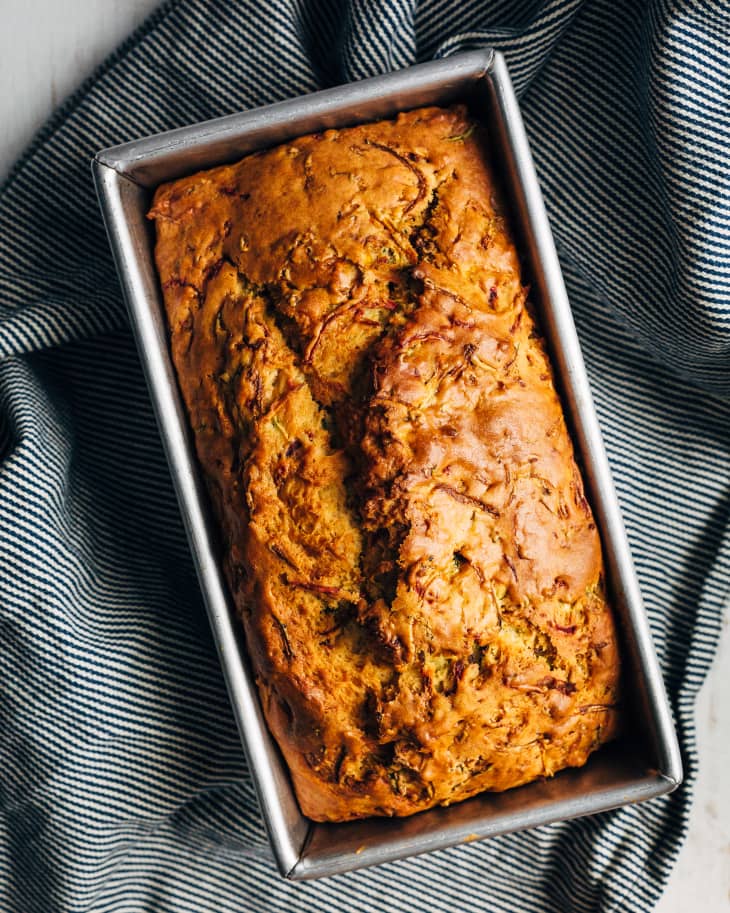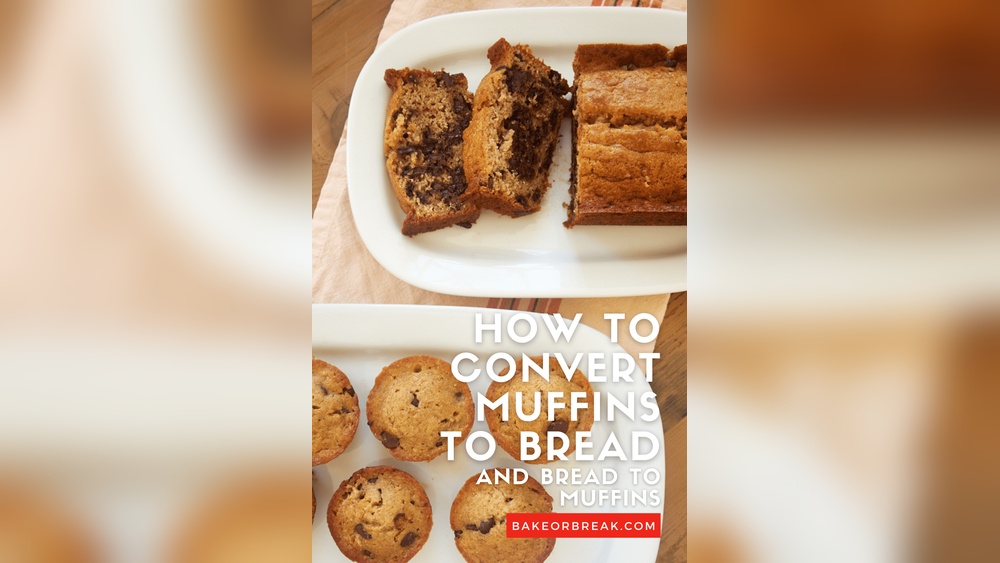Are you wondering how long to bake muffin mix in a loaf pan to get the perfect texture every time? You’re not alone.
Using muffin mix in a loaf pan is a great way to enjoy your favorite flavors in a new shape, but the baking time can be tricky. Bake it too short, and your loaf will be gooey in the middle.
Bake it too long, and it turns dry. You’ll discover the ideal baking time and handy tips to make sure your muffin loaf comes out moist, fluffy, and delicious every single time. Keep reading to unlock the secrets to baking success!
:max_bytes(150000):strip_icc()/VeganBananaBread-TheSpruce-953821a6bcf9454f9618332e9a52b6cb.jpg)
Credit: www.thespruceeats.com
Choosing The Right Loaf Pan
Choosing the right loaf pan matters a lot when baking muffins from a mix. The pan size and material affect how heat moves and how long your muffins take to bake. Picking the best pan helps you get even baking and a perfect texture.
Pan Size And Material
Loaf pans come in different sizes. A small pan holds less batter and bakes faster. A large pan holds more batter and needs more time. Choose a pan size that fits your recipe amount.
Material also changes baking results. Metal pans heat quickly and give a golden crust. Glass pans heat slower but keep heat longer. Silicone pans bake evenly but need longer time. Each material changes how heat reaches the batter.
Impact On Baking Time
Smaller pans shorten baking time. The batter cooks faster because heat reaches the center quickly. Larger pans need more time for the heat to cook the inside fully.
Metal pans reduce baking time. They transfer heat fast and cook muffins evenly. Glass and silicone pans need extra minutes to bake through.
Check muffins early when using metal pans. Add extra time for glass or silicone pans. Adjust your baking time based on pan size and material to avoid undercooked or burnt muffins.
Adjusting Oven Temperature
Baking muffin mix in a loaf pan needs careful temperature control. The shape and size of the pan change how heat reaches the batter. Adjusting oven temperature helps bake the muffins evenly and avoid overcooking or undercooking.
Different pans need different baking times and temperatures. Using the right temperature keeps the muffins moist and soft. It also creates a nice crust on top without burning.
Standard Temperature For Muffins
Muffins usually bake at 350°F (175°C). This temperature works well for regular muffin tins. It cooks the batter evenly and gives a light, fluffy texture. Baking at 350°F helps the muffins rise properly and avoids drying out.
Modifications For Loaf Pans
Loaf pans are bigger and deeper than muffin tins. Heat takes longer to reach the center of the batter. Lowering the oven temperature to 325°F (163°C) is best. This slower baking helps the loaf cook through without burning the outside.
Check the muffins with a toothpick after about 40 minutes. The baking time may be longer than regular muffins. Keep an eye on the color and texture to avoid overbaking.
Typical Baking Times
Baking muffin mix in a loaf pan takes different times depending on the pan size. Knowing typical baking times helps avoid undercooked or burnt muffins. This section covers common baking durations and tips for best results.
Small Vs Large Loaf Pans
Small loaf pans need less time to bake muffin mix. Usually, 30 to 40 minutes is enough. The heat reaches the center quicker because of the smaller size.
Large loaf pans take longer, around 50 to 60 minutes. The batter is thicker, so heat takes more time to cook it fully. Check the pan size before starting to bake.
Checking Doneness
Test doneness by inserting a toothpick into the loaf’s center. It should come out clean or with a few crumbs. Wet batter means more baking time is needed.
Look for a golden brown top and edges pulling away from the pan. These signs show the muffin loaf is ready to come out of the oven.
Tips For Even Baking
Baking muffin mix in a loaf pan needs care to get even results. Uneven baking leads to parts that are undercooked or overbaked. Use simple tips to help your loaf cook evenly and come out perfect every time.
Positioning In The Oven
Place the loaf pan in the center of the oven. This spot gets the most even heat. Avoid putting the pan too close to the oven walls or heating elements. The center position helps heat reach all sides of the pan equally. This reduces burnt edges and raw centers.
Rotating The Pan
Halfway through baking, turn the loaf pan 180 degrees. Ovens can have hot spots that cook unevenly. Rotating the pan balances this out. It ensures all sides get the same amount of heat. Use oven mitts to avoid burns. This small step improves your baking results a lot.
Common Baking Issues
Baking muffin mix in a loaf pan can sometimes lead to common problems. These issues affect the texture and taste of your baked good. Knowing these problems helps you fix them quickly. It also improves your baking results.
Underbaked Centers
Underbaked centers happen when the middle stays raw or gooey. This occurs if the baking time is too short or the oven temperature is too high. The outside cooks fast, but the inside stays wet. To avoid this, lower the oven temperature and bake longer. Check doneness by inserting a toothpick in the center. It should come out clean or with a few crumbs.
Overbaked Edges
Overbaked edges look dark and feel hard. This problem happens when the loaf bakes too long or the oven runs hot. The edges dry out while the center cooks. To prevent this, cover the pan loosely with foil partway through baking. It protects edges from burning. Also, use an oven thermometer to keep the temperature steady and correct.

Credit: www.thekitchn.com
Cooling And Serving
After baking muffin mix in a loaf pan, cooling and serving are key steps. Proper cooling helps the loaf set and makes slicing easier. Serving it right brings out the best taste and texture. Let’s explore the best ways to cool and serve your muffin loaf.
Resting Time
Remove the loaf from the oven carefully. Leave the pan on a cooling rack for 10 to 15 minutes. This short rest helps the loaf firm up slightly. Then, gently take the loaf out of the pan. Place it on the rack to cool completely. Cooling fully stops the cooking inside. It also prevents the loaf from being soggy. Wait at least 30 minutes before cutting into the loaf. This resting time keeps the texture soft and crumbly.
Best Serving Suggestions
Slice the loaf into even pieces. Serve plain or with a light spread like butter. Honey or jam adds a sweet touch. Warm slices taste wonderful, especially with tea or coffee. Try topping with cream cheese for a creamy flavor. For a quick snack, add fresh fruit on the side. Store leftovers in an airtight container. Keep at room temperature for up to two days. For longer storage, refrigerate or freeze slices.
:max_bytes(150000):strip_icc()/Convert-a-muffin-recipe-into-loaf-4097840_Final2-1c795ee18a594bf681352e6901c3827b.png)
Credit: www.thespruceeats.com
Frequently Asked Questions
How Long To Bake Muffin Mix In A Loaf Pan?
Bake muffin mix in a loaf pan for 35 to 45 minutes. Check doneness with a toothpick; it should come out clean. Oven temperature should be 350°F (175°C) for even baking and a moist texture.
Does Baking Time Vary With Loaf Pan Size?
Yes, larger loaf pans require longer baking times. A standard 9×5 inch pan takes 35-45 minutes, while smaller pans may bake faster. Always monitor closely and adjust time accordingly for best results.
Can I Use Muffin Mix For Bread Loaf Recipes?
Yes, muffin mix can be baked in a loaf pan as a quick bread. Adjust baking time to ensure it cooks through without drying out. It offers a convenient alternative for a moist, fluffy loaf.
Should I Reduce Oven Temperature For Loaf Pan Baking?
No need to reduce temperature; keep it at 350°F (175°C). Lowering temperature may cause undercooked centers. Maintain temperature but adjust baking time based on the pan size and batter thickness.
Conclusion
Baking muffin mix in a loaf pan takes a bit longer than in regular muffin cups. Expect about 35 to 45 minutes at 350°F (175°C). Check with a toothpick to see if it’s done. The toothpick should come out clean.
Avoid opening the oven too often to keep the heat steady. Let the loaf cool before slicing. This helps it set and taste better. With these tips, your loaf will turn out soft and delicious every time. Enjoy your homemade treat!

